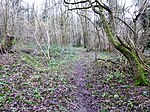Hougham Without
Civil parishes in KentDover DistrictKent geography stubsVillages in Kent

Hougham Without is a civil parish between Dover and Folkestone in southeast England. The main settlements are the villages of Church Hougham and West Hougham, collectively known simply as "Hougham". Great Hougham Court Farm is located to the south of the two villages, near the Dover transmitting station. The Channel Tunnel runs underground just south of West Hougham and directly under both Church Hougham and the Farm.
Excerpt from the Wikipedia article Hougham Without (License: CC BY-SA 3.0, Authors, Images).Hougham Without
Geographical coordinates (GPS) Nearby PlacesShow on map
Geographical coordinates (GPS)
| Latitude | Longitude |
|---|---|
| N 51.125 ° | E 1.23 ° |








